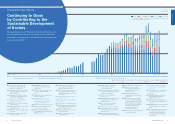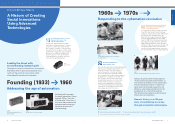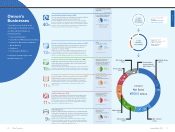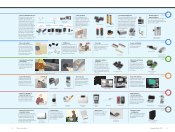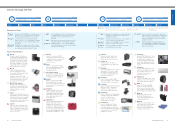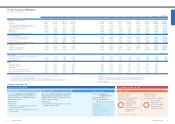Omron 2013 Annual Report Download - page 5
Download and view the complete annual report
Please find page 5 of the 2013 Omron annual report below. You can navigate through the pages in the report by either clicking on the pages listed below, or by using the keyword search tool below to find specific information within the annual report.
1960
World’s fi rst non-contact switch
6 Omron Corporation Integrated Report 2013 7
About Omron
1967
World’s fi rst fully unmanned train station system
Acting in accordance with the philosophy of
“To the machine, the work of the machine, to
man the thrill of creation,” Omron continued to
provide automation systems in response to
social needs for increased productivity and
effi ciency, making large contributions to the
development of a more fulfi lling society.
The Company also worked to automate social
infrastructure and healthcare.
1943
First domestically produced
micro switch
1960
Central R&D Laboratory after completion
of construction
Anticipating the coming of
the age of automation, Omron
declared 1955 as “Year One
of Automation.” Since then, it
has continued to evolve these
operations while working to
equate the Omron name
with technology.
Omron founder Kazuma Tateishi with engineers
Hands-on programming experience corner at
Sysmac exhibition
Omron’s history is an 80-year
story of contributing to society
through automation technologies.
Omron’s 80-Year History
A History of Creating
Social Innovations
Using Advanced
Technologies
1948
Current limiter
Founding (1933) 1960
1960s 1970s
Electronic and Mechanical Components Business (EMC)
Social Systems, Solutions and Service Business (SSB)
Industrial Automation Business (IAB)
Addressing the age of automation
Responding to the cybernation revolution
Leading the times with
an unrelenting intrepid spirit
The origins of Omron’s innovation lie in X-ray timers,
followed by the fi rst domestically produced micro
switch and the world’s fi rst non-contact switch,
all developed to lead industrial innovation.
Developing products to tackle
the electricity crises that
followed World War II
In May 1933, Kazuma Tateishi founded
Tateisi Electric Manufacturing Co., Omron’s
predecessor. In the years that followed,
the company continued to create products
that were the fi rst in Japan or in the world.
In 1948, the company was reborn as Tateisi
Electronics Co. after succeeding in the
mass-production of the current limiters
it had developed to tackle the electricity
crises that followed World War II.
Promoting automation
at production sites
At a time when automation in the manufacturing
industry was trending toward high-mix, low-
volume production, Omron was quick to
realize the need for controllers with high-
processing speeds that allowed programs
to be rewritten. Omron developed a sequence
programmer for machine tools in 1968, and
then in 1972 it released the revolutionary
programmable sequence controller called
Sysmac. After this, Omron continued to
promote the standardization of program
control manufacturing styles, making large
contributions to spreading automation and
improving productivity in factories.
Realizing improved operational
effi ciency and automation of
railway operations
To respond to the needs for improved opera-
tional effi ciency and automation in railway
operations, Omron introduced its multi-function
automated ticket vending machine into
Kobe Station of Japanese National Railways
(currently Japan Railways Group) in 1965.
Later, in 1966, Omron developed automated
ticket gates through a joint effort with Kinki
Nippon Railway and Kinki Sharyo Research
Institute. In 1967, three years before Expo ’70
was held in Osaka, Omron introduced the
world’s fi rst fully unmanned train station sys-
tem into Kita-Senri Station of Hankyu Railway.




